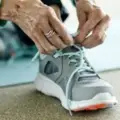*This page may contain affiliate links. When you buy through these links, we may earn a small commission at no extra cost to you.
You may have heard of rocker bottom shoes and even seen them at shoe and retail stores.
These shoes are usually shoes designed especially for people suffering from some kind of foot disorder.
And plantar fasciitis is one such problem in which the rocker bottom shoes prove useful.
But what are they, how do they work, and are they right for you if you suffer from conditions like plantar fasciitis?
Let’s try to answer all these questions in detail in the article below…

What are Rocker Bottom Shoes?
This is a type of shoe in which the sole is not flat but instead is bowed outward or is thicker in one area, which means that the shoe never sits flat on the surface.
Sometimes called toning shoes or rounded sole shoes, rocker bottom shoes are designed to replace standard footwear for those who have a loss in their range of motion.
The bowing effect can be in the middle of the sole or more pronounced towards the toes or back towards the heel.
There are several types of rocker bottom shoes available, which have been around since the 1990s.
Based on the type of sole they have, these can be categorized as follows:
- Mid Rocker
- Double Rocker
- Forefoot Rocker
- Toe Only Rocker
- Ankle Joint Rocker
- Heel to Toe Rocker
- Negative Heel Rocker
How Do Rocker Bottom Shoes Work?
The bowing causes the feet to not sit flat on the surface. This means additional muscles are put to work to provide proper balance when standing, walking, jogging, or running. The effect is two-fold.
Because the feet are not flat, it provides extra flexibility for those with some joint loss of motion.
For example, a rocker bottom shoe provides additional motion to compensate if a person loses flection in their big toe or toes.
The other effect is that balance is affected, so it must be compensated by using additional muscles in the glutes and legs.
The idea is that the shoes activate more muscle groups, so you burn more calories or tone muscles that otherwise would not be addressed with standard flat shoes.
While the data about the muscle toning effects are unclear, many who wear rocker bottom sole shoes have noticed the results.
Can Rocker Bottom Shoes Help in Plantar Fasciitis?
The primary benefit of rocker bottom shoes is that they provide additional motion for those who may suffer from some flexibility issues in the foot, toes, or ankles.
Because the range of motion is increased depending on the type of rocker’s bottom used, the result is that a person with flexibility issues in the toes, metatarsals, or ankles gets the added range of motion they need.
And for this reason, different types of rocker bottom shoes are recommended by podiatrists for people suffering from a range of different foot conditions, such as:
- Plantar Fasciitis
- Ankle Fusion
- Metatarsalgia
- Hallux Limitus
- Ankle Arthritis
- Midfoot Arthritis
The added benefit of burning more calories or improving muscle tone is less obvious.
While research is split in terms of such benefits, it is true that those who wear rocker-bottom shoes are more likely to experience better overall muscle tone when performing exercises that are focused on the legs, such as brisk walking, for example.
However, those with balance issues may want to avoid rocker-bottom shoes, depending on the severity of the condition.
Because the feet do not sit flat, it is possible to roll or go further in terms of the range of motion than the body can compensate.
It also means that for those with weak ankles, rocker bottoms may induce more sprains and injuries, although, for the most part, that is a minor concern.
- nu vot
- heel to toe rocker bottom shoes
- mbt rocker bottom shoes how to wear them






